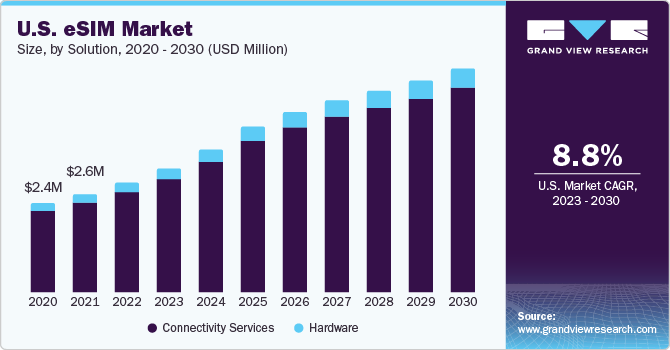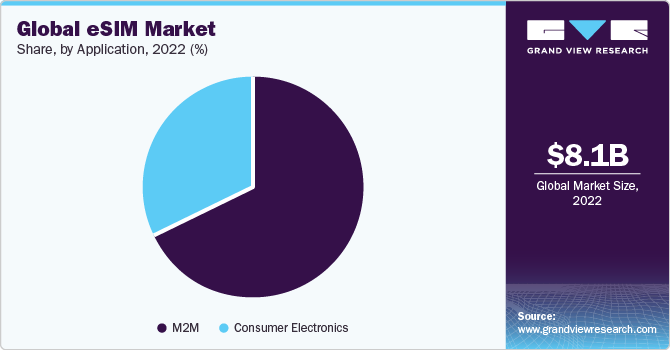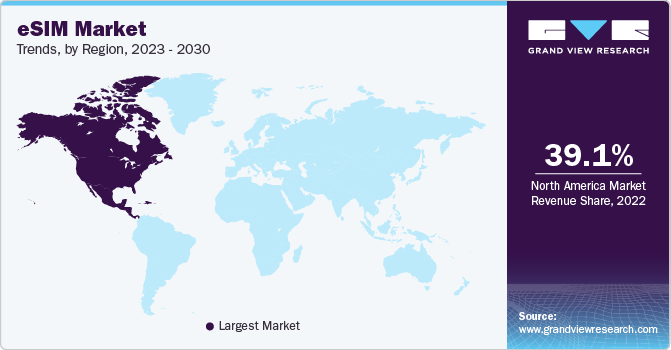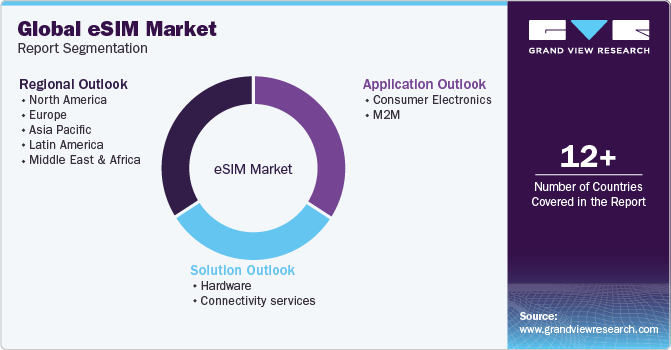- Home
- »
- Communication Services
- »
-
eSIM Market Size, Share & Trends Analysis Report, 2030GVR Report cover
![eSIM Market Size, Share & Trends Report]()
eSIM Market Size, Share & Trends Analysis Report By Solution (Hardware, Connectivity Services), By Application (Consumer Electronics, M2M), By Region, And Segment Forecasts, 2023 - 2030
- Report ID: GVR-4-68038-667-7
- Number of Report Pages: 206
- Format: PDF, Horizon Databook
- Historical Range: 2017 - 2021
- Forecast Period: 2023 - 2030
- Industry: Technology
eSIM Market Size & Trends
The global eSIM market size was valued at USD 8.07 billion in 2022 and is expected to grow at a compound annual growth rate (CAGR) of 7.9% from 2023 to 2030. The market growth is driven by the rising adoption of IoT-connected devices in M2M applications and consumer electronics. There is an upsurge in the number of times eSIM profiles were downloaded across consumer devices. The eSIM market is propelling due to the rise in the adoption of eSIM-connected devices. According to Mobilise, in 2021, there were 1.2 billion eSIM-enabled devices, with the number expected to climb to 3.4 billion by 2025.

The introduction of eSIM in the automobile industry has provided tremendous flexibility in providing cellular connectivity to trucks and cars while unlocking new capabilities and features. It is expected that within the next several years, all cars will be cellular enabled, resulting in a better driving experience facilitated by novel linked services. Recently, the automotive industry took a giant step toward enabling the next generation of connected automobiles by implementing the GSMA-embedded SIM specification to strengthen vehicle connectivity. It is intended to improve security for various connected services.
The eSIM-enabled solutions offer automatic interoperability across numerous SIM operators, connection platforms, and remote SIM profile provisioning. With multiple network service providers involved in the operating chain, maintaining the security of these systems has grown complicated. Mobile Network Operators' (MNOs') credentials are collected and kept by the eSIM in the device's inbuilt software, making them vulnerable to security breaches. Furthermore, the operation of eSIM across numerous physical platforms and MNOs exposes it to several virtual environment concerns. As a result, the operational flexibility provided by eSIM may be rendered ineffective if security is breached, impeding market expansion.
Industry 4.0 is a technological breakthrough that has introduced smart machinery with automatic communication and control. Industry 4.0 refers to a networked environment in which actionable data and information are transferred between Machine to Machine (M2M) and Machine to Other (M2O) devices via the Internet of Things (IoT). Wi-Fi, sensors, RFID (radio frequency administrations), and autonomous computing software are all used in M2M systems to analyze data and send it over a network for further processing. M2M systems frequently rely on public and cellular networks for internet access. These factors enabled the integration of electronic manufacturers with eSIM (embedded SIM cards) into M2M systems, thereby contributing to market expansion. By enabling M2M communication, eSIM technology has enabled advancements in the connected ecosystem.
The increasing penetration of smartphones across countries such as China, India, Japan, and the U.S. is further anticipated to fuel market growth. Smartphone manufacturers such as Google, Samsung Electronics Co., Apple, Inc., and Motorola Mobility LLC, Ltd. have started implementing eSIM technology into their smartphones in alliance with several network service providers. For instance, Apple, Inc. has partnered with six service providers, Ubigi, MTX Connect, Soracom Mobile, GigSky, Redtea Mobile, and Truphone, to offer eSIM service. Smartphone and consumer electronics manufacturers' increasing adoption of eSIM to provide an enhanced and secure user experience is expected to bolster market growth.
Solution Insights
The connectivity services segment accounted for the largest revenue share of 88.5% in 2022. This rapid expansion can be due to the increasing use of eSIM for M2M connections, which is expected to generate money for network operators through subscription services. MNOs (Mobile Network Operators) provide connectivity services for securely and remotely managing end-user cellular subscriptions. The automotive industry recently backed the GSMA Embedded SIM Specification to strengthen vehicle connection, paving the way for a new generation of connected vehicles. It is projected to improve security for various connectivity services, allowing the market to grow.
The hardware segment is expected to grow at the fastest CAGR of 13.5% during the forecast period. The increase in consumer electronics manufacturers is anticipated to fuel the demand and contribute to segment growth. The growing trend among smartphone manufacturers to integrate eSIM into the device fuels demand and contributes to segment growth. The hardware segment market is consolidated with a few eSIM chipset companies, such as Infineon Technologies AG, NXP Semiconductors, and STMicroelectronics, holding a significant share of the overall hardware revenue.
Application Insights
The M2M segment held the largest revenue share of 68.1% in 2022. The increasing use of eSIM technology in the automobile industry for M2M communication propels the M2M segment. Furthermore, connected cars are the primary demand drivers in the automotive industry. eSIM implementation in the automobile industry is projected to substantially simplify production and drive the expansion of the connected car market. It is expected to encourage other industries to adopt M2M and IoT technologies.

The consumer electronics segment is expected to grow at the fastest CAGR of 9.2% over the forecast period. Consumer electronics application remains one of the significant forces shaping innovation, growth, and disruption across several technology sectors. The use of eSIM in smartphones lets device manufacturers use the space in the device as less space is required for the eSIM. Therefore, device manufacturers are adopting technology to design relatively slimmer smartphones. eSIM is projected to be a game-changer in consumer electronics applications. High reliability, improved safety, and enhanced connectivity are some of the features driving the adoption of eSIM in consumer electronic applications.
Regional Insights
North America dominated the market and accounted for the largest revenue share of 39.1% in 2022. and is expected to grow at the fastest CAGR of 8.7% over the forecast period. The growth is due to the network providers' high presence and the region's fastest technological advancements. The growth is due to the network providers' high presence and the region's fastest technological advancements.
Europe is expected to grow significantly during the forecast period. European companies are the early adopters of the latest technologies. At the same time, the regions are headquarters to several prominent market players, such as Giesecke+Devrient Mobile Security GmbH, NXP Semiconductors N.V., STMicroelectronics, and others. These areas also witness the rising adoption of smart connected devices and cars. Due to all these factors, these two regions are expected to maintain their lead during the forecast period.

Asia Pacific is expected to grow significantly during the forecast period. Prominent smartphone players like Huawei and Samsung Electronics have launched eSIM smartphones, driving eSIM momentum in the smartphone market and positioning eSIM as the future mainstream SIM technology for connected devices. Furthermore, several OEMs across countries such as China and India are developing eSIM solutions and gathering joint development forces across the ecosystem to create tactical development paths. For instance, in June 2021, IDEMIA, an eSIM manufacturing company, opened a new production capacity in India, which is expected to increase the eSIM production capacity globally. According to German digital solutions firm Giesecke+Devrient (G&D), 25-30% of smartphones have eSIM capability till 2024.
Key Companies & Market Share Insights
The industry players are undertaking strategies such as product launches, acquisitions, and collaborations to increase their global reach. For instance, in September 2022, BICS, digital communications, services, mobility, and IoT company, partnered with Thales to simplify integration for IoT to streamline integration for the Internet of Things (IoT). Through this strategic collaboration, the companies seek to establish an open ecosystem for eSIM technology in the IoT domain. The aim is to enable seamless integration and utilization of eSIMs, which can contribute to enhancing the connectivity and operational efficiency of IoT deployments across diverse industries.
The industry competition is anticipated to intensify further as many companies focus on developing advanced, cost-effective solutions and technologies. For instance, eSIM makes it easier for consumers to change their mobile operators; thus, increasing consumers' switching between network providers will result in intense competition between the network operators. Furthermore, in September 2021, Deutsche Telekom AG announced the launch of in-car 5G and personal eSIM networking options in collaboration with Bayerische Motoren Werke AG. Deutsche Telekom AG and Bayerische Motoren Werke AG used personal eSIM and MobilityConnect to link vehicle connectivity with the customer's mobile network on a 5G basis. The following are some of the major participants in the global eSIM market
-
Arm Limited
-
Deutsche Telekom AG
-
Giesecke+Devrient GmbH
-
Thales
-
Infineon Technologies AG
-
KORE Wireless
-
NXP Semiconductors
-
Sierra Wireless
-
STMicroelectronics
-
Workz
Recent Developments
-
In May 2023, Lonestar Cell MTN, a South African conglomerate, introduced eSIM technology in Liberia. This advancement allows subscribers to switch to eSIM-compatible devices without the hassle of removing physical SIM cards. Customers can scan a QR code provided at any Lonestar Cell MTN service center.
-
In March 2023, Gcore, a public cloud and content delivery network company, launched its Zero-Trust 5G eSIM Cloud platform. This platform offers organizations across the globe a secure and dependable high-speed networking solution. By utilizing Gcore's software-defined eSIM, companies can establish secure connections to remote devices, corporate resources, or Gcore's cloud platform through regional 5G carriers.
-
In February 2023, Amdocs, a software company, collaborated with Drei Austria to introduce a groundbreaking eSIM solution. This collaboration enables Drei Austria's customers to access the advantages of digital eSIM technology through a fully app-based experience. The innovative "up" app offers a seamless and entirely digital SIM journey powered by Amdocs' eSIM technology at Drei Austria.
-
In December 2022, Grover, a subscription-based electronics rental platform, joined forces with Gigs, a telecom-as-a-service platform, to introduce Grover Connect, its very own mobile virtual network operator (MVNO), in the U.S. Through Grover Connect, customers in the U.S. can effortlessly activate any eSIM-enabled technology device, eliminating the complexities associated with carrier offers and contracts that may not align with their device rental duration.
-
In October 2022, Bharti Airtel, a telecommunications service provider based in India, unveiled its "Always On" IoT connectivity solutions. This offering enables seamless connectivity for IoT devices across multiple Mobile Network Operators (MNOs) through an embedded SIM (eSIM) technology. Particularly beneficial for vehicle tracking providers, auto manufacturers, and scenarios where equipment operates in remote areas, requiring uninterrupted and widespread connectivity.
eSIM Market Report Scope
Report Attribute
Details
Market size value in 2023
USD 9.07 billion
Revenue forecast in 2030
USD 15,464.0 million
Growth Rate
CAGR of 7.9% from 2023 to 2030
Base year for estimation
2022
Historical data
2017 - 2021
Forecast period
2023 - 2030
Report updated
October 2023
Quantitative units
Revenue in USD million/billion and CAGR from 2023 to 2030
Report coverage
Revenue forecast, company ranking, competitive landscape, growth factors, and trends
Segments covered
Solution, application, region
Regional scope
North America; Europe; Asia Pacific; Latin America; and MEA
Country scope
U.S.; Canada; UK; Germany; France; China; Japan; India; Australia; South Korea; Brazil; Mexico; Saudi Arabia; South Africa; UAE
Key companies profiled
Arm Limited; Deutsche Telekom AG; Giesecke+Devrient GmbH; Thales; Infineon Technologies AG; KORE Wireless; NXP; Semiconductors; Sierra Wireless; STMicroelectronics;
Workz
Customization scope
Free report customization (equivalent up to 8 analyst’s working days) with purchase. Addition or alteration to country, regional & segment scope
Pricing and purchase options
Avail customized purchase options to meet your exact research needs. Explore purchase options
Global eSIM Market Report Segmentation
This report forecasts revenue growth at global, regional, and country levels and provides an analysis of the latest industry trends in each of the sub-segments from 2017 to 2030. For this study, Grand View Research has segmented the global eSIM market based on solutions, application, and regions:

-
Solution Outlook (Revenue in USD Million, 2017 - 2030)
-
Hardware
-
Connectivity services
-
-
Application Outlook (Revenue in USD Million, 2017 - 2030)
-
Consumer Electronics
-
Smartphones
-
Tablets
-
Smartwatches
-
Laptop
-
Others
-
-
M2M
-
Automotive
-
Smart Meter
-
Logistics
-
Others
-
-
-
Regional Outlook (Revenue in USD Million, 2017 - 2030)
-
North America
-
U.S.
-
Canada
-
-
Europe
-
UK
-
Germany
-
France
-
-
Asia Pacific
-
China
-
Japan
-
India
-
Australia
-
South Korea
-
-
Latin America
-
Brazil
-
Mexico
-
-
Middle East and Africa
-
Saudi Arabia
-
South Africa
-
UAE
-
-
Frequently Asked Questions About This Report
b. The global eSIM market size was estimated at USD 8.07 billion in 2022 and is expected to reach USD 9.07 billion in 2023.
b. The global eSIM market is expected to grow at a compound annual growth rate of 7.9% from 2023 to 2030 to reach USD 15,464.0 million by 2030.
b. North America dominated the eSIM market with a share of 39% in 2022. The growth is due to network providers' high presence and the region's fastest technological advancements.
b. Some key players operating in the eSIM market include Arm Limited, Deutsche Telekom AG, Giesecke+Devrient GmbH, Thales, Infineon Technologies AG, KORE Wireless, NXP, Semiconductors, Sierra Wireless, STMicroelectronics, and Workz.
b. The market growth is driven by the rising adoption of IoT-connected devices in M2M applications and consumer electronics. There is an upsurge in the number of times eSIM profiles were downloaded across consumer devices. The eSIM market is propelling due to the rise in the adoption of eSIM-connected devices.
Share this report with your colleague or friend.
![gvr icn]()
NEED A CUSTOM REPORT?
We can customize every report - free of charge - including purchasing stand-alone sections or country-level reports, as well as offer affordable discounts for start-ups & universities. Contact us now
![Certified Icon]()
We are GDPR and CCPA compliant! Your transaction & personal information is safe and secure. For more details, please read our privacy policy.
We are committed towards customer satisfaction, and quality service.
"The quality of research they have done for us has been excellent."





